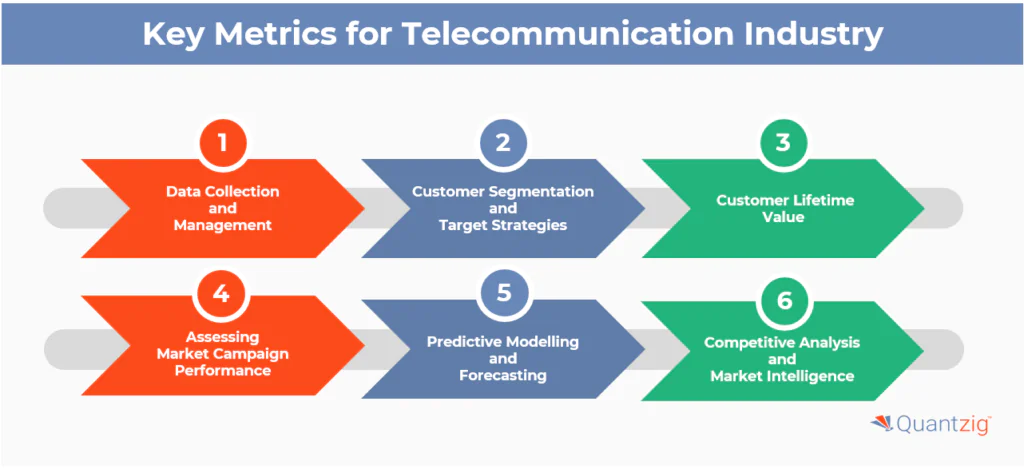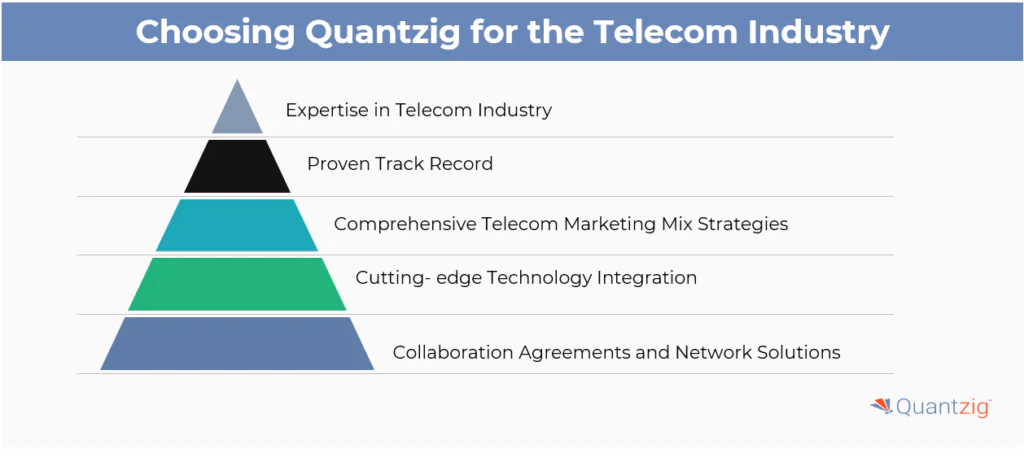Table of Contents
Introduction for Marketing Mix of Telecom Industry
In the fast-paced and highly competitive telecommunications companies, an effective marketing strategy is crucial for success. Quantzig, a leading analytics and advisory firm, has crafted a comprehensive Telecom Marketing Solution for its clients to enhance their return on investment (ROI). In this article, we will delve into the key components of this solution, exploring the Marketing Mix, business strategies, and the significance of each element in driving success.
Book a Marketing Mix demo to experience the meaningful insights we derive from data through our analytical tools and platform capabilities. Schedule a demo today!
Request a free demoQuantzig’s Success Story
Challenges Faced by the Client
A leading telecommunication industry player in the US wanted to increase its market share in the retail space based on marketing mix modeling of advertising spends. The client had operations across multiple geographies and wanted to understand the impact of its media investments at both national and local levels for Bundles of products such as – wireless, internet, and cable television. There was a need to improve profitability and cost savings based on optimized media spending.
Following up on this need to improve profitability, the client connected with our experts to understand the full scope of telecom market mix solutions and the multi-service networks like Video, data, Internet, and voice services for their industry.
Quantzig’s Telecom Marketing Solution for the Client
Quantzig’s solution for the telecommunication company is designed to address the unique challenges of the telecommunications industry and maximize ROI for clients. By integrating innovative strategies, broadband access and leveraging industry expertise, our solution ensures a holistic approach to telecom marketing techniques that aligns with the ever-evolving landscape of technology, business customers and consumer preferences. By assessing competitor sales data, media spending, and GRPs for display, paid search, social media, and purchase funnel indicators, our analytics team collected data to develop effective marketing mix models and marketing techniques.
Industry Overview
To identify and attract high-value customers in today’s volatile telecommunication industry, organizations must allocate advertising and media spend wisely, this is where the telecom market mix comes in. Successful marketing mix modeling projects require contributions from both the business and technical teams. With the advent of digital channels, digital platforms relevant, personal digital experiences and the shift in consumption patterns of the customers, marketing mix modeling and techniques like broadband access need to be updated with the unprecedented demand for more real-time and customized solutions.
Marketing mix modeling and marketing techniques estimate the impact/effectiveness of media executions across channels like broadband access to determine the ROI and incremental sales. It helps this industry players predict future media investments and allocate funds in a more precise manner. It also helps in creating brand and product awareness, and customer loyalty to drive penetration and influence customers to upgrade service providers and Bundles of product packages.
Introduction to Marketing Analytics in the Telecom Industry
Marketing analytics in the telecommunication companies involves analyzing customer data to improve marketing strategies and decision-making. It helps telecom companies understand customer behavior, preferences, and trends. Telecom companies use marketing analytics for their communication needs, communication technology like digital marketing, personalized marketing, data-driven marketing and to optimize their marketing campaigns, target specific customer segments, and increase customer engagement. By leveraging marketing analytics, telecom companies can identify opportunities for upselling and cross-selling to existing customers. The insights gained from marketing analytics and the consultative selling techniques in the telecom industry can also aid in improving customer retention and reducing customer churn rates.
How Does Marketing Mix of Telecom Industry Benefit Businesses?
Effective telecom marketing analytics is essential for success in the fast-paced and ever-evolving telecommunications industry. These companies must navigate a dynamic landscape, adapting their strategies to technological advancements and shifting business customers and consumer preferences. The Marketing Mix, encompassing the 4Ps (Product, Price, Place, and Promotion), is a strategic framework that, when leveraged effectively, offers numerous benefits for telecom businesses. Here are the four key advantages that these strategies bring to the table.
1. Enhanced Product Differentiation and Innovation:
One of the primary benefits of implementing these strategies is the ability to enhance Bundles of product differentiation and foster innovation. In a market saturated with similar offerings, the companies under this industry must find unique selling points to stand out. Through the Product development and product element of the Marketing Mix, businesses can strategically develop and introduce cutting-edge products and service providers.
For instance, by focusing on high-end audio devices, projection display devices, and intelligent agent machines, companies can differentiate themselves from competitors. This not only attracts new customers intrigued by innovative offerings but also retains existing ones by providing a diverse and advanced product portfolio. Additionally, the continuous integration of breakthrough technologies like artificial intelligence (AI) services and voice recognition technology ensures that the product line remains at the forefront of industry trends with seamless experiences that leads to winning customer experiences.
2. Optimal Pricing Strategies for Market Competitiveness:
The Price component of this marketing strategy plays a pivotal role in shaping customer perceptions and influencing purchasing decisions. Companies can benefit significantly by developing and implementing optimal pricing strategies using first-party intelligence that align with market demands and competitor offerings.
Through meticulous analysis of the market, customer preferences, and cost structures or budgets, businesses can design pricing plans that not only remain competitive but also cater to different segments of the market. Examples such as T&T Sharing plans, mobile subsidies, and monthly shareable data plans demonstrate the flexibility and adaptability of pricing strategies. These plans are tailored to meet diverse customer needs, ensuring that the pricing element becomes a tool for attracting and retaining customers in a highly competitive landscape.
3. Efficient Distribution Channels for Market Penetration:
The Place element of this tool focuses on the efficient distribution of products and services to reach a wider audience. In an industry where accessibility and availability are critical, establishing effective distribution channels is imperative for market penetration and increased customer base.
Telecom companies can leverage network solution services, leased line solutions, and Internet data center solutions to ensure that their service providers are widely accessible. By strategically placing infrastructure and partnering with key players, businesses can extend their reach to both urban and rural areas. This not only broadens the customer base but also enhances the brand’s visibility and presence in the market.
4. Strategic Promotions for Brand Visibility and Loyalty:
Effective promotional strategies, the fourth element of this tool, contribute to increased brand visibility and customer loyalty. Advertising initiatives that highlight technological advancements, such as LTE networks, 5G capabilities, and breakthrough technologies, position the brand as an industry leader.
Promotion is not only about attracting new customers but also about retaining existing ones. By incorporating unlimited texting, intranet work voice calls, and other value-added services in promotional activities, companies can strengthen customer loyalty. This not only reinforces the brand’s value proposition but also encourages customer retention in a highly dynamic and competitive market.
Experience the advantages firsthand by testing a customized complimentary pilot designed to address your specific requirements. Pilot studies are non-committal in nature.
Request a free pilotKey Metrics and KPIs for Telecom Marketing Analytics:
In telecom marketing analytics, and marketing strategy key metrics and KPIs play a crucial role in assessing performance and informing strategic decisions. Metrics such as customer acquisition cost (CAC), customer churn rate, and average service revenue per user (ARPU) provide valuable insights into the effectiveness of marketing campaigns. KPIs like customer retention rate, customer churn rate and net promoter score (NPS) gauge customer satisfaction and loyalty. Additionally, tracking digital advertising metrics such as click-through rates and conversion rates helps optimize marketing spend. These metrics, analyzed through comprehensive data analysis and reporting dashboards, enable telecom marketers to optimize campaigns, improve ROI, and stay competitive in the telecommunications industry.

Data Collection and Management for Telecom Marketing Analytics:
Efficient data collection and management are imperative for successful telecom marketing analytics, especially for the mobile telecommunication. By leveraging robust systems and tools, telecom companies can gather diverse datasets encompassing customer demographics, usage patterns, and market trends. Centralized data repositories and streamlined processes ensure data integrity and accessibility for analysis. Advanced techniques like data warehousing and integration facilitate comprehensive reporting and analysis. Moreover, adherence to regulatory compliance and data privacy standards is paramount to safeguard customer information. Effective data collection and management lay the foundation for accurate insights and informed decision-making in telecom marketing.
Customer Segmentation and Targeting Strategies:
Customer segmentation and targeting are essential strategies in telecom marketing to effectively reach diverse audience segments. Utilizing market research and competitive intelligence, telecom companies can identify distinct customer personas and preferences. Segmentation criteria may include demographic factors, usage behaviors, and psychographic traits. By tailoring campaigns and offers to specific segments, telecom marketers can enhance relevance and benefits of new technologies and performance. Moreover, leveraging digital advertising platforms enables precise targeting based on factors like location and interests. Through strategic segmentation and targeting, telecom companies can maximize ROI and drive sustainable growth in a competitive marketplace while negating the chief marketing challenges.
Analyzing Customer Lifetime Value (CLV):
Analyzing Customer Lifetime Value (CLV) is paramount for telecom marketers to assess the long-term profitability of customer relationships and the infrastructure. By evaluating service revenue generated over the entire customer lifecycle and factoring in acquisition and retention costs, telecom companies gain insights into the value of individual customers. This analysis guides strategic decisions related to customer acquisition, retention, and upselling efforts. Advanced analytics techniques, such as predictive modeling, and infrastructure enhance CLV analysis by forecasting future service revenue potential. By prioritizing high CLV customers and implementing targeted retention strategies, telecom marketers can optimize campaigns and maximize overall ROI in the telecommunications industry while solving chief marketing challenges.
Assessing Marketing Campaign Performance:
Assessing marketing campaign performance is critical for optimizing strategies and maximizing ROI in the telecommunications industry. Through comprehensive data analysis and reporting dashboards, marketers gain insights into key metrics and KPIs such as conversion rates, customer acquisition cost (CAC), and return on investment (ROI). This analysis enables informed decision-making and facilitates adjustments to campaign elements for improved performance. By tracking digital advertising metrics, infrastructure and audience engagement, marketers can identify trends and opportunities for optimization, ensuring that campaigns align with strategic goals and effectively target the intended audience.
Predictive Modeling and Forecasting in Telecom Marketing:
Predictive modeling and forecasting empower telecom marketers to anticipate future trends and customer behaviors with greater accuracy. By leveraging historical data and advanced analytics techniques, such as machine learning algorithms, marketers can develop predictive models to forecast outcomes and inform strategic decisions. These models enable proactive campaign planning and resource allocation, minimizing risks and maximizing opportunities for success. Additionally, predictive modeling aids in identifying customer segments with the highest potential value, guiding targeted marketing efforts and enhancing overall campaign effectiveness in the competitive telecommunications industry. This also helps in getting beyond the chief marketing challenges.
Competitive Analysis and Market Intelligence:
Competitive analysis and market intelligence are essential for telecom marketers to stay ahead in a rapidly evolving industry landscape. By gathering and analyzing data on competitors’ strategies, market trends, business customers and consumer preferences, marketers gain valuable insights into the competitive landscape. This intelligence informs strategic decision-making, enabling marketers to identify gaps, capitalize on emerging trends, and differentiate their offerings effectively. Through comprehensive market research and competitor benchmarking, telecom marketers can adapt their strategies, optimize campaigns, and maintain a competitive edge in the dynamic telecommunications market.
Leveraging Artificial Intelligence (AI) in Telecom Marketing Analytics:
Leveraging artificial intelligence (AI) in telecom marketing analytics revolutionizes data analysis and decision-making processes. AI-powered algorithms enhance data processing capabilities, enabling marketers to extract deeper insights from large and complex datasets. By utilizing AI-driven predictive analytics, marketers can forecast customer behavior, personalize marketing strategies, and optimize campaign performance. Moreover, AI-powered tools facilitate real-time monitoring and optimization of digital advertising campaigns, ensuring relevance and effectiveness. With AI-driven insights, telecom marketers can make data-driven decisions, enhance customer engagement, and drive growth in the competitive telecommunications industry.
Predictive Insights for Telecom Marketing Mix Modeling
- Comparative ROI analysis across media types based on advanced regression methods for each product (wireless, internet, and cable)
- Insight into contribution of brand equity advertising on incremental sales at national and local levels
- Campaign analysis of individual campaigns to understand the ROI and incremental sales generated at a granular level for cable television
- Synergy analysis to identify direct and indirect impact of media types on incremental sales and the ROI generated.
Why Choose Quantzig to Implement Marketing Mix of Telecom Industry?

- Expertise in Telecom Industry: Quantzig’s team boasts a deep understanding of the telecommunications sector, staying abreast of industry trends, and technological advancements. This expertise allows them to tailor customized solutions that resonate with the target audience.
- Proven Track Record: With a history of successful implementations, we garnered recognition, including the prestigious Global Telecoms Award. The firm’s commitment to innovation and excellence positions it as a reliable partner for clients seeking impactful solutions.
- Comprehensive Telecom Marketing Mix Strategies: We adopt a strategic approach encompassing the 4Ps – Product, Price, Place, and Promotion. By meticulously addressing each element, this Solution optimizes product offerings, pricing strategies, distribution channels, and promotional activities for maximum impact.
- Cutting-edge Technology Integration: The solution incorporates breakthrough technologies such as artificial intelligence (AI) services and voice recognition technology, ensuring that clients stay ahead of the curve and deliver a seamless customer experience.
- Collaboration Agreements and Network Solutions: Our solution facilitates collaboration agreements, leveraging interconnection and network solutions to enhance service delivery. This fosters a robust ecosystem for clients, promoting efficiency and customer satisfaction.
Apart from that, there are a few more benefits that you can gather with Quantzig customizing your solutions.
- Improved ability to quantify marketing effectiveness of channels and events in terms of ROI, revenue, contributions, and incremental sales
- Supported future investment decisions based on simulated scenarios
- Created a real-time solution for investment decisions, providing executive management a powerful decision support system.
Get started with your complimentary trial today and delve into our platform without any obligations. Explore our wide range of customized, consumption driven analytical solutions services built across the analytical maturity levels.
Start your free trialConclusion
Quantzig’s Solution is a strategic blend of industry expertise, innovative technologies, and comprehensive marketing mix strategies. By addressing each element meticulously, the solution not only maximizes ROI but also positions clients as leaders in the dynamic telecommunications landscape. The firm’s commitment to employee empowerment, global recognition, and technological integration solidifies its position as a preferred partner for clients seeking sustainable success in the telecom industry.




